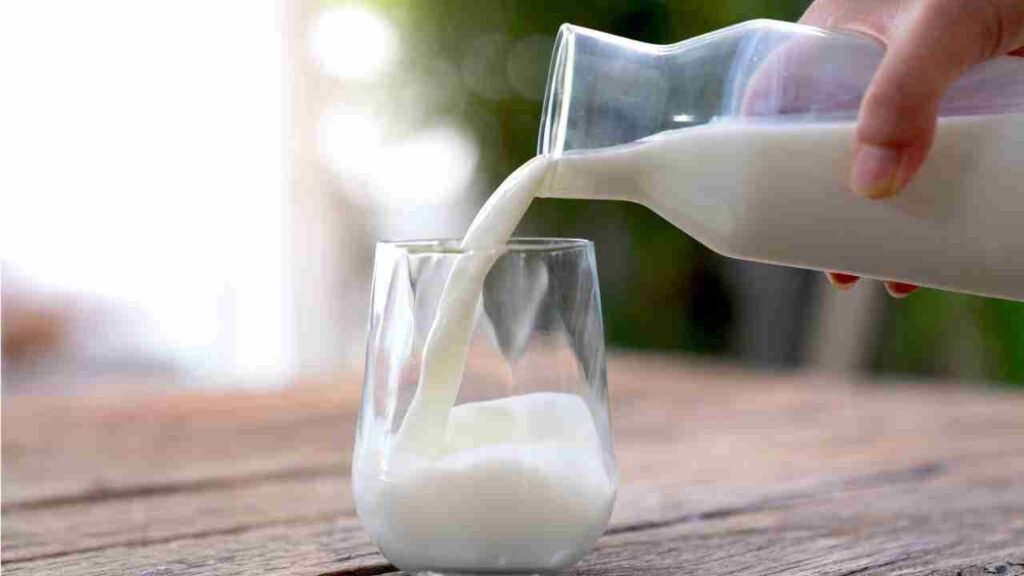Welcome, milk enthusiasts, curious minds, and health aficionados! Today, we embark on a journey through the creamy cosmos of milk – a beverage that has been a staple in human diets for millennia. Join me as we dive into the multifaceted world of milk, exploring its origins, nutritional benefits, cultural significance, and more. So, grab a glass of your favorite variety, whether it’s dairy or plant-based, and let’s venture into the Milky Way!

The Origins of Milk:
Milk, in its various forms, has played a crucial role in human history. It’s believed that our ancestors began consuming milk from animals over 10,000 years ago, marking the dawn of animal domestication. Initially, milk served as sustenance for the young of mammals but eventually became a valuable food source for humans as well.
The process of domesticating animals like cows, goats, and sheep allowed humans to harness milk as a readily available source of nutrition. From the Eurasian steppes to the African savannas, the practice of milking animals spread across different cultures and civilizations, shaping dietary habits and culinary traditions.
The journey of milk from being a nourishing substance for the young of mammals to a dietary staple for humans is a fascinating tale deeply woven into the fabric of human history. Over 10,000 years ago, our ancestors embarked on a transformative relationship with animals, marking the dawn of domestication and the beginning of a symbiotic bond that would shape the course of civilization.
Initially, milk served as nature’s perfect food, designed by evolution to provide essential nutrients for the growth and development of offspring. Across various species, from cows and goats to sheep and camels, lactation was a fundamental aspect of maternal care, ensuring the survival of newborns in the harsh realities of the wild.
However, it was the ingenuity of early humans that propelled milk from its role as a sustenance for the young to a valuable resource for adults. The process of domesticating animals like cows, goats, and sheep marked a pivotal moment in human history, as it allowed humans to harness the nutritional bounty of milk for themselves.
The journey of milk from the Eurasian steppes to the African savannas, and beyond, is a testament to human adaptability and resourcefulness. As early humans transitioned from a nomadic lifestyle to settled agricultural communities, the practice of milking animals became increasingly widespread, shaping dietary habits and culinary traditions across diverse cultures and civilizations.
In ancient Mesopotamia, for example, archaeological evidence suggests that dairy farming was practiced as early as 7000 BCE, with dairy products like cheese and yogurt being staples of the diet. Similarly, in ancient Egypt, depictions of cattle and scenes of milking can be found in tomb paintings, highlighting the importance of milk in Egyptian society.
The spread of milking practices was not confined to a single region or civilization but occurred independently across multiple continents and cultures. From the Indus Valley civilization in South Asia to the Mesoamerican cultures of Central America, the consumption of milk and dairy products became integral to dietary customs and culinary traditions.
In addition to its nutritional value, milk also held symbolic significance in many cultures, often associated with fertility, abundance, and purity. In ancient Greece, for instance, milk was offered to the gods as a libation during religious ceremonies, symbolizing the nurturing and life-giving qualities of the divine.
Nutritional Benefits of Milk:
- Calcium for Strong Bones:
- Milk is rich in calcium, a mineral essential for building and maintaining strong bones and teeth.
- Adequate calcium intake during childhood and adolescence is crucial for achieving peak bone mass, which helps reduce the risk of osteoporosis later in life.
- Regular consumption of milk can help prevent bone-related conditions and promote overall skeletal health.
- Vitamin D Absorption:
- Vitamin D, often referred to as the “sunshine vitamin,” plays a critical role in calcium absorption and bone metabolism.
- Milk is often fortified with vitamin D, ensuring optimal absorption of calcium from the diet.
- Vitamin D deficiency can lead to weakened bones and increased susceptibility to fractures, making milk an important dietary source of this essential nutrient.
- Protein for Muscle Repair and Growth:
- Milk is a complete protein source, containing all nine essential amino acids necessary for muscle repair, growth, and maintenance.
- Proteins in milk, such as casein and whey, are easily digestible and provide a sustained release of amino acids to support muscle recovery after exercise.
- Including milk in post-workout nutrition can help promote muscle protein synthesis and enhance athletic performance.
- Vitamin B12 for Nervous System Function:
- Milk is a good source of vitamin B12, a water-soluble vitamin essential for the proper functioning of the nervous system.
- Adequate intake of vitamin B12 is necessary for the production of red blood cells and DNA synthesis, as well as maintaining cognitive function and mood regulation.
- Incorporating milk into the diet can help prevent vitamin B12 deficiency, which can lead to fatigue, weakness, and neurological symptoms.
- Potassium for Heart Health:
- Milk contains potassium, an electrolyte that plays a crucial role in maintaining fluid balance, nerve transmission, and muscle contraction.
- Potassium helps regulate blood pressure by counteracting the effects of sodium and promoting vasodilation of blood vessels.
- Consuming milk as part of a balanced diet can support heart health and reduce the risk of hypertension and cardiovascular disease.
- Phosphorus for Bone Health and Energy Metabolism:
- Phosphorus is another essential mineral found in milk, contributing to bone mineralization, energy metabolism, and cellular function.
- Together with calcium, phosphorus forms the structural framework of bones and teeth, providing strength and rigidity to the skeletal system.
- Milk provides a natural source of phosphorus, ensuring optimal bone health and overall metabolic function.
Cultural Significance:
The cultural significance of milk transcends its nutritional value, weaving through the tapestry of human societies and traditions with profound symbolism and culinary creativity. Let’s delve deeper into its multifaceted importance:
- Symbolism of Purity and Fertility:
- Across various cultures, milk is often revered as a symbol of purity, fertility, and nourishment. Its association with nurturing qualities and life-giving properties has led to its incorporation into religious rituals and ceremonies.
- In Hinduism, for instance, milk holds immense spiritual significance and is considered a sacred offering to deities during prayers and festivals. The act of pouring milk over idols or offering it in ceremonial rituals symbolizes devotion, purity, and the bestowing of blessings.
- Religious and Ceremonial Practices:
- Milk plays a central role in religious observances and rites in many cultures, serving as a conduit for spiritual communion and divine blessings.
- In Christianity, milk is symbolically linked to purity and spiritual nourishment, often referenced in biblical passages as a metaphor for the teachings of Christ and the sustenance of faith.
- Similarly, in Islam, milk is mentioned in the Quran as a symbol of abundance and divine providence, representing the blessings bestowed upon believers by Allah.
- Culinary Inspiration and Innovation:
- Beyond its symbolic significance, milk has inspired a rich culinary heritage, giving rise to an array of delectable dishes and delicacies across cultures.
- From creamy desserts like ice cream, custard, and rice pudding to savory delights like cheese, yogurt, and paneer, milk serves as a versatile ingredient in cuisines around the world.
- Each culture has developed its own unique repertoire of milk-based recipes, showcasing the ingenuity and creativity of culinary traditions passed down through generations.
- For example, in Italian cuisine, milk forms the foundation of beloved dishes like creamy risottos, decadent tiramisu, and a variety of artisanal cheeses, reflecting the rich dairy farming heritage of the region.
- Cultural Identity and Heritage:
- Milk and dairy products often hold a special place in the cultural identity and heritage of communities, serving as markers of tradition and belonging.
- In pastoral societies and agrarian communities, the rearing of dairy animals and the production of milk-based products are integral to social and economic life, shaping cultural practices and customs.
- Festivals and celebrations centered around dairy products, such as cheese fairs and yogurt festivals, provide occasions for communities to come together, celebrate their culinary heritage, and share in the joys of communal feasting.
The Rise of Plant-Based Milks:
The emergence and widespread adoption of plant-based milks in recent years have marked a significant shift in consumer preferences and dietary trends, reshaping the landscape of the dairy industry and catering to a growing demand for alternative options. Let’s explore the various facets of the rise of plant-based milks:
- Catering to Diverse Dietary Needs:
- Plant-based milks have gained popularity among individuals with specific dietary requirements or restrictions, such as lactose intolerance, dairy allergies, or those adhering to vegan lifestyles.
- For individuals who experience discomfort or adverse reactions to dairy products due to lactose intolerance or dairy allergies, plant-based milks offer a welcome alternative that is free from lactose and allergens.
- Moreover, plant-based milks align with ethical and environmental considerations, appealing to consumers concerned about animal welfare, sustainability, and the environmental impact of conventional dairy farming practices.
- Derived from a Variety of Sources:
- Plant-based milks are derived from a diverse range of plant sources, including almonds, soybeans, oats, coconut, rice, hemp, and peas, among others.
- Each plant-based milk variety offers its own unique flavor profile, texture, and nutritional composition, allowing consumers to choose options that suit their taste preferences and dietary needs.
- Nutritional Benefits and Fortification:
- Plant-based milks are often fortified with vitamins and minerals to match or exceed the nutritional profile of dairy milk, providing essential nutrients such as calcium, vitamin D, vitamin B12, and protein.
- Fortification ensures that plant-based milks offer comparable nutritional benefits to dairy milk, addressing concerns about potential nutrient deficiencies in non-dairy alternatives.
- Additionally, plant-based milks may contain beneficial phytonutrients and antioxidants inherent to their plant sources, further enhancing their nutritional value.
- Diverse Flavors and Textures:
- Plant-based milks offer a wide array of flavors and textures, ranging from creamy and nutty to light and refreshing, catering to diverse taste preferences and culinary applications.
- Varieties such as almond milk, soy milk, oat milk, and coconut milk each impart their own distinct characteristics, making them suitable for use in various recipes, beverages, and culinary creations.
- Innovation and Market Expansion:
- The growing popularity of plant-based milks has spurred innovation and market expansion, leading to a proliferation of new products, brands, and flavors in the dairy-free beverage category.
- Manufacturers continue to develop new formulations and production techniques to enhance the taste, texture, and nutritional quality of plant-based milks, further driving consumer interest and adoption.
Conclusion:
As we conclude our journey through the Milky Way of milk, it’s evident that this humble beverage holds a special place in human history, culture, and cuisine. Whether enjoyed in its traditional dairy form or embraced in its plant-based variations, milk continues to nourish and delight people around the globe. So, here’s to milk – a timeless classic that never fails to captivate our senses and nurture our bodies. Cheers!
Top 20 FAQs about The Milky Way: Exploring the Wonders of Milk
- What is milk?
- Milk is a nutrient-rich fluid produced by mammals to nourish their offspring. In the context of human consumption, it typically refers to the fluid secreted by dairy animals like cows, goats, and sheep.
- What nutrients are found in milk?
- Milk is rich in essential nutrients such as calcium, vitamin D, protein, vitamin B12, potassium, and phosphorus, which are vital for bone health, muscle growth, and overall well-being.
- Why is milk considered nutritious?
- Milk contains a unique combination of nutrients, including calcium and protein, which are essential for bone health, muscle development, and various physiological functions in the body.
- What are the health benefits of drinking milk?
- Drinking milk can contribute to stronger bones, improved dental health, enhanced muscle recovery, and reduced risk of osteoporosis and other bone-related conditions.
- Is milk suitable for people with lactose intolerance?
- Some individuals with lactose intolerance may experience digestive discomfort or symptoms after consuming dairy milk. However, lactose-free and lactose-reduced milk options are available to accommodate their dietary needs.
- What are the different types of milk available?
- There are various types of milk available, including cow’s milk (whole, skim, and low-fat), goat’s milk, sheep’s milk, and plant-based milks derived from sources like almonds, soybeans, oats, and coconut.
- Is organic milk better than conventional milk?
- Organic milk is produced without synthetic pesticides, hormones, or antibiotics, and may offer some potential health and environmental benefits. However, both organic and conventional milk can provide essential nutrients.
- Can milk consumption help with weight loss?
- While milk is a nutrient-rich beverage, its calorie content should be considered as part of a balanced diet. Consuming moderate amounts of milk, along with a healthy diet and regular exercise, can support weight management goals.
- Is milk safe for infants and young children?
- Breast milk is the ideal source of nutrition for infants, providing essential nutrients and antibodies for optimal growth and development. However, infant formula or fortified cow’s milk may be suitable alternatives for infants who are not breastfed.
- How does milk production impact the environment?
- Dairy farming practices, including land use, water consumption, and greenhouse gas emissions, can have environmental implications. Sustainable farming practices and innovations are being implemented to minimize the environmental footprint of milk production.
- What role does milk play in culinary traditions around the world?
- Milk is a versatile ingredient used in a wide range of culinary creations, from creamy desserts and savory dishes to beverages and baked goods. It holds cultural significance in many cuisines and culinary traditions worldwide.
- Are there any cultural or religious customs involving milk?
- Milk holds symbolic significance in various cultural and religious rituals, ceremonies, and celebrations. It is often offered as a sacred offering to deities, used in traditional ceremonies, or incorporated into festive foods and beverages.
- How do plant-based milks compare to dairy milk in terms of nutrition?
- Plant-based milks offer alternatives to dairy milk for individuals with dietary restrictions or preferences. They may be fortified with vitamins and minerals to match the nutritional profile of dairy milk, but their composition varies depending on the plant source.
- Can milk be consumed by people with dairy allergies?
- Individuals with dairy allergies must avoid consuming dairy milk and products made from cow’s milk. Plant-based milks provide suitable alternatives for those with dairy allergies, offering lactose-free and allergen-free options.
- What are the environmental benefits of consuming plant-based milks?
- Plant-based milks generally have a lower environmental footprint compared to dairy milk, as they require fewer natural resources, produce fewer greenhouse gas emissions, and may have less impact on land and water resources.
- How can milk be safely stored and handled?
- Milk should be stored in the refrigerator at or below 40°F (4°C) to maintain freshness and prevent bacterial growth. It’s essential to handle milk safely, including using clean utensils, avoiding cross-contamination, and observing expiration dates.
- What are the common misconceptions about milk?
- Common misconceptions about milk include beliefs about its role in causing acne, contributing to mucus production, or being harmful to bone health. Scientific evidence does not support these myths, and milk can be part of a healthy diet for most individuals.
- Are there any ethical considerations related to dairy farming?
- Ethical considerations in dairy farming include animal welfare concerns, such as housing conditions, treatment practices, and the separation of calves from their mothers. Sustainable and humane farming practices are increasingly prioritized by consumers and producers.
- What innovations are shaping the future of milk production and consumption?
- Innovations in milk production and consumption include advancements in dairy farming technology, plant-based milk formulations, sustainable packaging, and alternative protein sources. These innovations aim to address consumer preferences, health concerns, and environmental sustainability.
- How can I incorporate milk into my diet in creative ways?
- Milk can be enjoyed in various ways, such as drinking it plain, using it as a base for smoothies, incorporating it into cereal or oatmeal, or using it in cooking and baking recipes. Experimenting with different milk varieties and recipes can add variety and nutritional value to your diet.
Register for My Upcoming Masterclass HERE
See You in the Live Masterclass
Sunil Chaudhary stands as a preeminent global Leading digital coach, boasting a diverse clientele hailing from over 50 nations. Renowned for his prowess as an exemplary SEO expert, business automation coach, and landing page authority, Chaudhary also holds the distinction of being esteemed as the finest business coach in India. Beyond technical domains, he imparts invaluable insights into mindset, success, and life skills, thus encompassing a holistic approach to mentorship.
Join FREE Courses HERE
Know The Author:
 Sunil Chaudhary aka Suniltams Guruji is India’s Leading Digital Coach. He provides complete Digital Skill Development Coaching with great support. Sunil has trained more than 25000 students and helped more than 1100 businesses so far. Sunil is a well-known face across the world for Digital Coaching.
Sunil Chaudhary aka Suniltams Guruji is India’s Leading Digital Coach. He provides complete Digital Skill Development Coaching with great support. Sunil has trained more than 25000 students and helped more than 1100 businesses so far. Sunil is a well-known face across the world for Digital Coaching.
Digital Success Coach | Best SEO Coach India | Mindset Coach | Life Success Coach
Related posts:
 Almond vs Soy Milk: Which is a Healthier Option?
Almond vs Soy Milk: Which is a Healthier Option?
 Embracing Life’s Sweetness and Bitterness: Exploring the Metaphor of Milk and Honey
Embracing Life’s Sweetness and Bitterness: Exploring the Metaphor of Milk and Honey
 The Ultimate Guide to Milk Powder: Everything You Need to Know
The Ultimate Guide to Milk Powder: Everything You Need to Know
 चमकदार त्वचा के लिए सरल और प्राकृतिक तरीके
चमकदार त्वचा के लिए सरल और प्राकृतिक तरीके
 Remembering Rinky Chakma: Former Miss India Tripura 2017, A Beacon of Beauty and Resilience
Remembering Rinky Chakma: Former Miss India Tripura 2017, A Beacon of Beauty and Resilience
 Oats vs Millets: Which is a Nutritious Choice?
Oats vs Millets: Which is a Nutritious Choice?
 The Link Between Weight and Fertility: Exploring the Challenges of Conception
The Link Between Weight and Fertility: Exploring the Challenges of Conception
 Psoriasis and Heart Disease: Expert Explains How This Skin Condition Increases Cardiac Issues
Psoriasis and Heart Disease: Expert Explains How This Skin Condition Increases Cardiac Issues
 Boost Your Respiratory Immunity with a Naturopathic Diet During Weather Transitions
Boost Your Respiratory Immunity with a Naturopathic Diet During Weather Transitions







